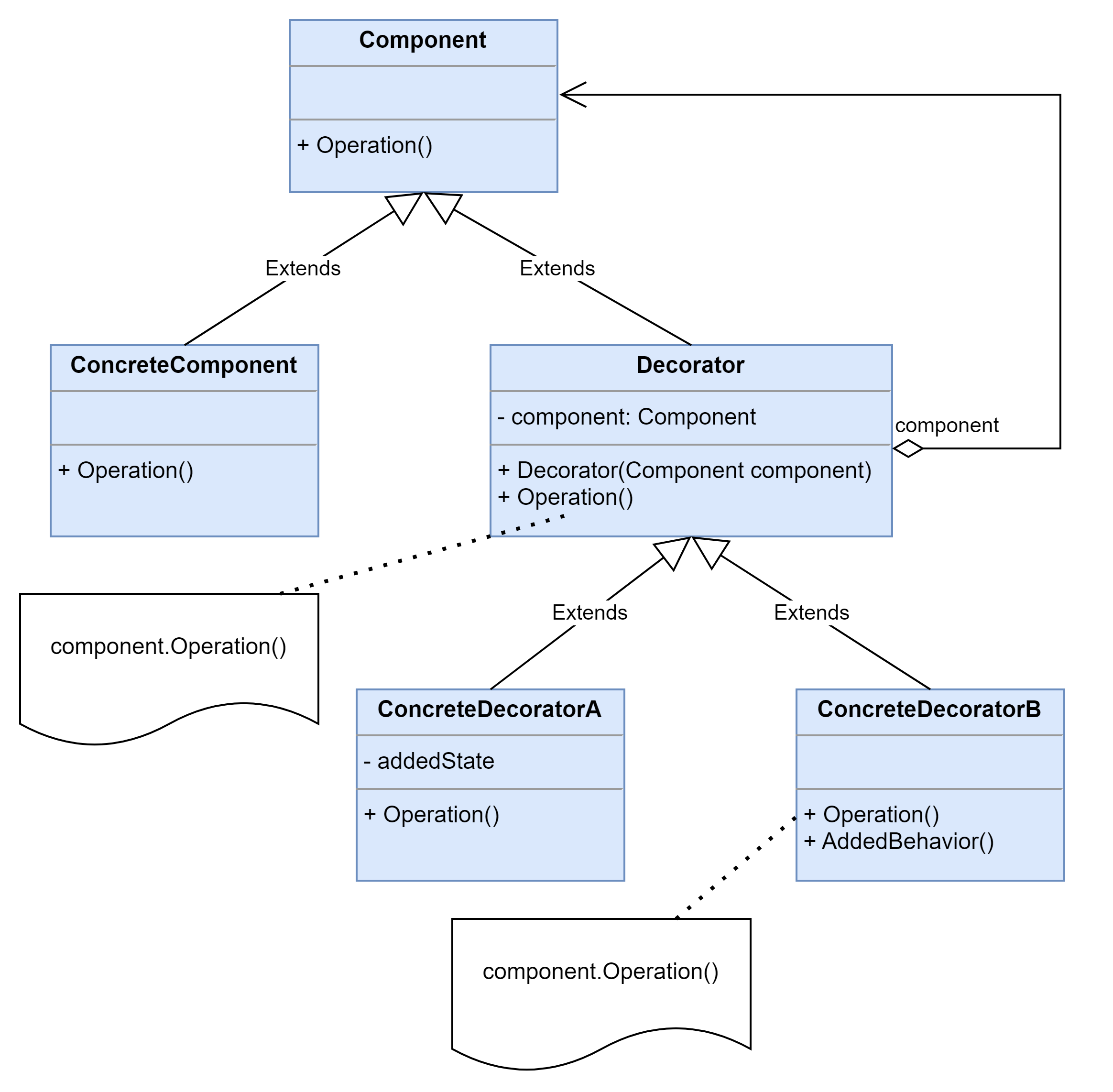装饰模式 (Decorator Pattern) - 扩展系统功能
动态地给一个对象增加一些额外的职责,就增加对象功能来说,装饰模式比生成子类实现更为灵活。装饰模式是一种对象结构型模式。
结构图
- Component(抽象构件):它是具体构件和抽象装饰类的共同父类,声明了在具体构件中实现的业务方法,它的引入可以使客户端以一致的方式处理未被装饰的对象以及装饰之后的对象,实现客户端的透明操作。
- ConcreteComponent(具体构件):它是抽象构件类的子类,用于定义具体的构件对象,实现了在抽象构件中声明的方法,装饰器可以给它增加额外的职责(方法)。
- Decorator(抽象装饰类):它也是抽象构件类的子类,用于给具体构件增加职责,但是具体职责在其子类中实现。它维护一个指向抽象构件对象的引用,通过该引用可以调用装饰之前构件对象的方法,并通过其子类扩展该方法,以达到装饰的目的。
- ConcreteDecorator(具体装饰类):它是抽象装饰类的子类,负责向构件添加新的职责。每一个具体装饰类都定义了一些新的行为,它可以调用在抽象装饰类中定义的方法,并可以增加新的方法用以扩充对象的行为。
由于具体构件类和装饰类都实现了相同的抽象构件接口,因此装饰模式以对客户透明的方式动态地给一个对象附加上更多的责任,换言之,客户端并不会觉得对象在装饰前和装饰后有什么不同。装饰模式可以在不需要创造更多子类的情况下,将对象的功能加以扩展。\
由于在抽象装饰类Decorator中注入的是Component类型的对象,因此我们可以将一个具体构件对象注入其中,再通过具体装饰类来进行装饰;此外,我们还可以将一个已经装饰过的Decorator子类的对象再注入其中进行多次装饰,从而对原有功能的多次扩展。
示例
using System;
namespace DesignPatterns.Composite
{
// The base Component interface defines operations that can be altered by
// decorators.
public abstract class Component
{
public abstract string Operation();
}
// Concrete Components provide default implementations of the operations.
// There might be several variations of these classes.
class ConcreteComponent : Component
{
public override string Operation()
{
return "ConcreteComponent";
}
}
// The base Decorator class follows the same interface as the other
// components. The primary purpose of this class is to define the wrapping
// interface for all concrete decorators. The default implementation of the
// wrapping code might include a field for storing a wrapped component and
// the means to initialize it.
abstract class Decorator : Component
{
protected Component _component;
public Decorator(Component component)
{
this._component = component;
}
public void SetComponent(Component component)
{
this._component = component;
}
// The Decorator delegates all work to the wrapped component.
public override string Operation()
{
if (this._component != null)
{
return this._component.Operation();
}
else
{
return string.Empty;
}
}
}
// Concrete Decorators call the wrapped object and alter its result in some
// way.
class ConcreteDecoratorA : Decorator
{
public ConcreteDecoratorA(Component comp) : base(comp)
{
}
// Decorators may call parent implementation of the operation, instead
// of calling the wrapped object directly. This approach simplifies
// extension of decorator classes.
public override string Operation()
{
return $"ConcreteDecoratorA({base.Operation()})";
}
}
// Decorators can execute their behavior either before or after the call to
// a wrapped object.
class ConcreteDecoratorB : Decorator
{
public ConcreteDecoratorB(Component comp) : base(comp)
{
}
public override string Operation()
{
return $"ConcreteDecoratorB({base.Operation()})";
}
}
public class Client
{
// The client code works with all objects using the Component interface.
// This way it can stay independent of the concrete classes of
// components it works with.
public void ClientCode(Component component)
{
Console.WriteLine("RESULT: " + component.Operation());
}
}
class Program
{
static void Main(string[] args)
{
Client client = new Client();
var simple = new ConcreteComponent();
Console.WriteLine("Client: I get a simple component:");
client.ClientCode(simple);
Console.WriteLine();
// ...as well as decorated ones.
//
// Note how decorators can wrap not only simple components but the
// other decorators as well.
ConcreteDecoratorA decorator1 = new ConcreteDecoratorA(simple);
ConcreteDecoratorB decorator2 = new ConcreteDecoratorB(decorator1);
Console.WriteLine("Client: Now I've got a decorated component:");
client.ClientCode(decorator2);
}
}
}运行结果
1
2
3
4
5
Client: I get a simple component:
RESULT: ConcreteComponent
Client: Now I've got a decorated component:
RESULT: ConcreteDecoratorB(ConcreteDecoratorA(ConcreteComponent))
总结
装饰模式降低了系统的耦合度,可以动态增加或删除对象的职责,并使得需要装饰的具体构件类和具体装饰类可以独立变化,以便增加新的具体构件类和具体装饰类。
优点
- 对于扩展一个对象的功能,装饰模式比继承更加灵活性,不会导致类的个数急剧增加。
- 可以通过一种动态的方式来扩展一个对象的功能,通过配置文件可以在运行时选择不同的具体装饰类,从而实现不同的行为。
- 可以对一个对象进行多次装饰,通过使用不同的具体装饰类以及这些装饰类的排列组合,可以创造出很多不同行为的组合,得到功能更为强大的对象。
- 具体构件类与具体装饰类可以独立变化,用户可以根据需要增加新的具体构件类和具体装饰类,原有类库代码无须改变,符合“开闭原则”。
缺点
- 使用装饰模式进行系统设计时将产生很多小对象,这些对象的区别在于它们之间相互连接的方式有所不同,而不是它们的类或者属性值有所不同,大量小对象的产生势必会占用更多的系统资源,在一定程序上影响程序的性能。
- 装饰模式提供了一种比继承更加灵活机动的解决方案,但同时也意味着比继承更加易于出错,排错也很困难,对于多次装饰的对象,调试时寻找错误可能需要逐级排查,较为繁琐。
适用场景
- 在不影响其他对象的情况下,以动态、透明的方式给单个对象添加职责。
- 当不能采用继承的方式对系统进行扩展或者采用继承不利于系统扩展和维护时可以使用装饰模式。不能采用继承的情况主要有两类:第一类是系统中存在大量独立的扩展,为支持每一种扩展或者扩展之间的组合将产生大量的子类,使得子类数目呈爆炸性增长;第二类是因为类已定义为不能被继承(如Java语言中的final类或C#语言中的sealed类)。
This post is licensed under CC BY 4.0 by the author.
